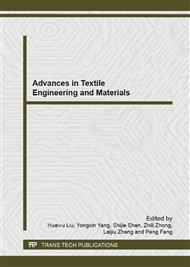p.734
p.737
p.741
p.745
p.751
p.756
p.761
p.765
p.770
Polylactic Acid Bone Scaffolds Made by Heat Treatment
Abstract:
Polylactic acid (PLA) has a widespread application, such as bone scaffolds, in biomedical field. This study creates PLA bone scaffolds, which has a structural stability, by using 150 denier (D) PLA plied yarn. 75 D PLA filaments are combined and then twisted into plied yarn. During the twisting process, the twists per inch (TPI) are varied. The resulting plied yarn undergoes heat treatment, and then is evaluated with mechanical property tests, determining an optimal TPI of 9. The plied yarn is then braided into PLA bone scaffolds. PLA bone scaffolds, thermally treated or not, are observed by a stereomicroscope and tested for porosity and tensile strength. According to test results, the optimal TPI is 9, which results from the optimal tensile strength. However, the variation in elongation of various 150 D plied yarn is not significant. When observed by a stereomicroscope, PLA bone scaffolds, which are thermally treated, have a compact filament arrangement. This is due to thermal bonding between filaments; in addition, the heat treatment duration is short, so the PLA filaments are not melted completely, resulting in a stable, hollow structure. According to porosity and tensile strength test, PLA bone scaffolds that are thermally treated exhibit a lower porosity and tensile strength due to the compact arrangement and tender phenomenon of the filaments. As a result, the optimal PLA bone scaffolds are made of 150 D plied with a TPI of 9, followed by a heat treatment at 165 °C for ten minutes.
Info:
Periodical:
Pages:
751-755
Citation:
Online since:
December 2012
Authors:
Price:
Сopyright:
© 2013 Trans Tech Publications Ltd. All Rights Reserved
Share:
Citation:


